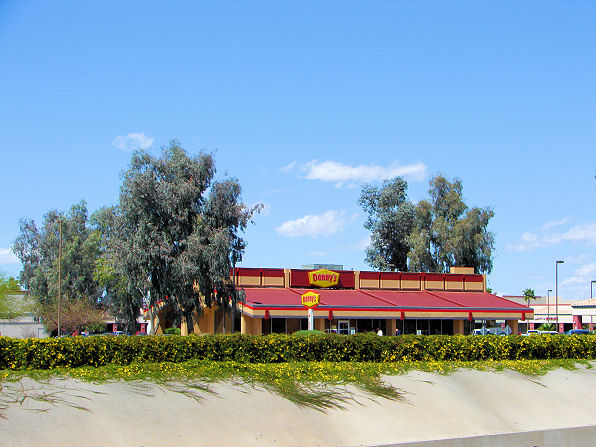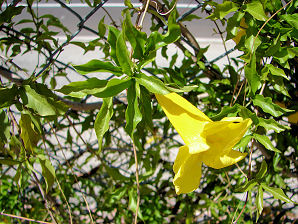Xeriscape Landscaping Plants For The Arizona Desert Environment.
Pictures, Photos, Information, Descriptions,
Images, & Reviews.
Vines.
Cat Claw Ivy, Macfadyena unguis - cati.
We Are Proud Of Our SafeSurf Rating!
Click On Any Of The Following Links By Amazon.Com
For Books, & Videos About Wildflowers Of Arizona & The Southwest USA. No Obligation!
 |
| Cat Claw Ivy, Macfadyena unguis cati. Photo Taken In Glendale, Arizona. On April 5, 2006. Used On I 17 Freeway To Cover Wire Fence. |
|---|
 | |
| Cat Claw Ivy. Macfadyena unguis cati. | Cat Claw Ivy. Macfadyena unguis cati. |
|---|
 /
/

Cat Claw Ivy.
We wish to thank Wikipedia, the free encyclopedia for some of the information on this page. We share images and information with Wikipedia. This attractive, shrubby, evergreen, twining climber gives a short spring display of showy yellow blossoms. It is a good ornamental cover for fences or walls, or of growing across lattice for shade. It will take full sun. It is a fast grower, with stems 10 to 18 feet long. The stems are red - brown aging to a green color then becoming woody up to about 6 inches thick. The leaves are divided into a glossy green, 3 tip leaflet with a two ovate-lanceolate, glossy green cladodes about 2 inches long per petiole and a 3 pronged claw-like climbing appendage. The flowers are single or in small clusters, yellow, trumpet like, up to 3/4 inches long with 5 petals. They turn into a thin capsule fruit about 12 - 18 inches long which is green ripening to brown in the summer, developing winged seeds. It has tuberous, deep, extensive roots. It's seeds are dispersed by wind and water. Formerly known as Doxantha unguis-cati or Bignonia tweediana.
Quick Notes:
Height: Height to about 25 feet. Equal or greater spread. Usually about 10 to 18 feet tall and long.
Flowers: Bright yellow, solitary, funnel-shaped. 2 inches long, 1-1/4 inch diameter. Short Bloom.
Flowering Time: April in Phoenix.
Seed Pod: A very long thin pod, 12 - 18 inches long and about 1/2 inch wide. It has winged seeds about 4 � 1 cm in size.
Leaves: Dark green, ovate-lanceolate, 2 inches long, entire or lower ones irregularly pinnately divided and a 3 pronged claw-like climbing appendage.
Found: Native to the Yucatan Peninsula of Mexico, Guatemala, Brazil, & Argentina. The USDA claims it is native of the USA (FL, GA, HI, LA, SC, TX), USA+ (PR, VI).
Hardiness: Said to only be hardy to 20 �F, but some people are growing it in colder areas.
Soil pH requirements:
Sun Exposure:
Elevation: 0 - 2,500 feet.
Habitat: Well drained sandy desert soils, clay soils, and disturbed rocky soil. Used in landscaping.
Miscellaneous: Flowering Photos Taken At I 17 & Northern Ave, Glendale, Arizona. April 5, 2006. Said to be a terrible vine to grow if you live in a moist climate. In hot, dry Arizona, it is not so invasive.
|



We Are Proud Of Our SafeSurf Rating!
Click On Any Of The Following Links By Amazon.Com
For Books, & Videos About Xerioscape Plants Of Arizona & The Southwest USA. No Obligation!
Back To Arizona Xeriscape Landscaping Main Page.
Back To Xeriscape Vines Page One.
Back To Arizona Wild Flowers Home Page
Back To DeLange Home Page
© 1966 - Present, Audrey, Eve, & George DeLange
| © 1966 - Present, Audrey, Eve, & George DeLange |


